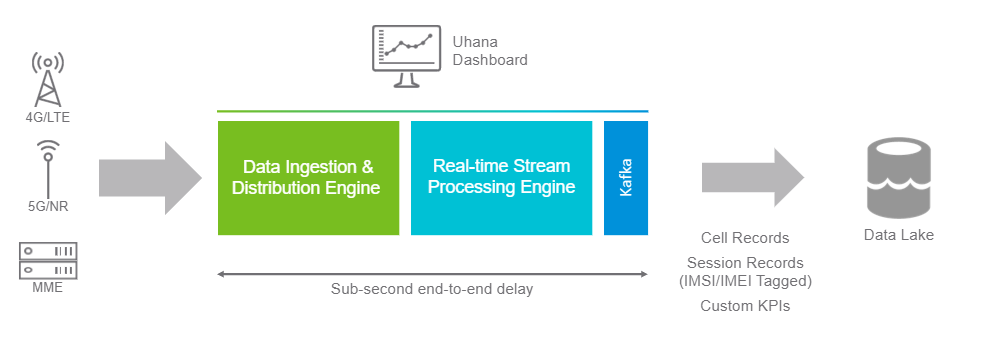This topic describes event-related data source details leveraged from streaming telemetry information from the radio access network (RAN) and the mobile core network into the Uhana by VMware platform. Uhana by VMware uses data sources to provide real-time, subscriber-level insights about your network.
Data sources are 4G/LTE or 5G/NR data and mobile core network elements; specifically, eNodeBs (LTE), gNodeBs (NR) and mobility management entities (MMEs). Other data sources can be added on request as the architecture allows stream processing and joining of arbitrary data sources.
RAN KPIs are calculated based on telemetry data and depicted in the Uhana by VMware dashboard.
The following diagram depicts the flow of data from 4G/LTE and 5G/NR networks and the MME.

Data sources create fine-grained session level events and stream them to a data processing location, known as the Data Ingestion and Distribution Engine (DIDE). The DIDE ingests, decodes, and performs quality checks to ensure completeness and integrity of information, then forwards the data to the Real-time Stream Processing Engine (RSPE). The RSPE collates various events and creates a session record based on session identifiers.
With Uhana by VMware you can customize KPIs which are published using Kafka and can be ingested by a database.
Data can also be shared with other receivers, such as data lakes (pictured).
RAN and core telemetry information, also known as traces, UE traces, and UE trace mapping, has been specified by 3GPP (sections 32.421, 32.422 and 32.423). Network equipment providers use specific terminology for trace information. Some examples on what several vendors call trace information are included in the Vendor trace information details table. This document uses the phrase trace information, although examples might refer to a specific term.
Table 1. Vendor trace information details
| Vendor | Term | |
|---|---|---|
| Ericsson | Call Trace Record (CTR) | |
| Huawei | Performance Call History Record | (PCHR) |
| Nokia | Cell Trace or Per-Call Measurement Data (PCMD) |
For information on your vendor trace information or their managed services, see the online documentation for your specific vendor.
For information about what other sources can consume Uhana by VMware data, see Consuming data.
Trace information detail
Each network equipment provider defines a specific format of trace information. Various levels of granularity can be configured using the respective element management system (EMS). The level of granularity is dependent on the use-cases served by the Uhana by VMware platform (for example, which event types). Exact requirements are determined with your main SRE contact.